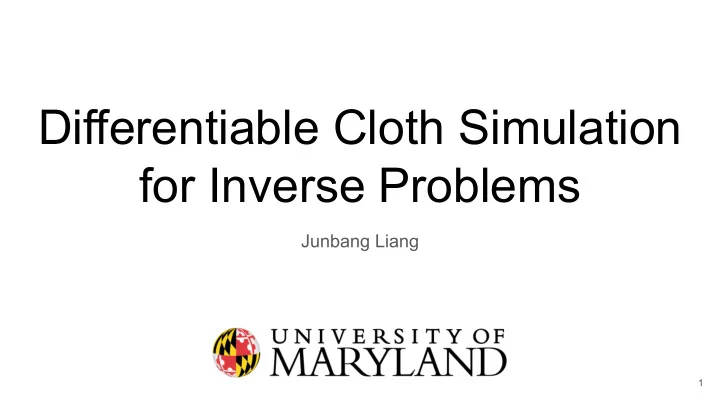

Differentiable Cloth Simulation for Inverse Problems Junbang Liang 1
Content ● Motivation ● Related Work ● Our Method ○ Simulation pipeline ○ Gradient Computation ● Results 2
Motivation ● Differentiable Physics Simulation as a Network Layer ○ Physical property estimation ○ Control of physical systems 3
Motivation ● Differentiable Physics Simulation as a Network Layer ○ Physical property estimation ○ Control of physical systems 4 Yang et al. (2017) Demo of our differentiable simulation
Content ● Motivation ● Related Work ● Our Method ○ Simulation pipeline ○ Gradient Computation ● Results 5
Related Work ● Differentiable rigid body simulation ○ Formulation not scalable to high dimensionality Belbute-Peres et al. 2019 Degrave et al. 2019 6
Related Work ● Learning-based physics [Li et al. 2018] ○ Unable to guarantee physical correctness 7
Our Contributions ● Dynamic collision handling to reduce dimensionality ● Gradient computation of collision response using implicit differentiation ● Optimized backpropagation using QR decomposition 8
Content ● Motivation ● Related Work ● Our Method ○ Simulation pipeline ○ Gradient Computation ● Results 9
Introduction to Simulation ● Partial differential equation (PDE) of Newton’s law: ● Solve satisfying , where ● Discretization to ordinary differential equations (ODE): ● Solve satisfying , where 10
Introduction to Simulation ● Partial differential equation (PDE) of Newton’s law: ● Solve satisfying , where ● Discretization to ordinary differential equations (ODE): ● Solve satisfying , where 11
Point Cloud Simulation Flow 1. 2. ○ S ○ Newton’s method 3. 4. 12
Cloth Simulation Flow 1. 2. ○ S ○ Newton’s method 3. 4. 5. 13
Collision Response ● 14
Collision Response ● 15
Mesh Simulation Flow: Backpropagation Gradient computation available? 1. Handled by auto-differentiation 2. ○ S ○ Newton’s method 3. Handled by auto-differentiation 4. 5. Handled by auto-differentiation 16
Mesh Simulation Flow: Backpropagation Gradient computation available? 1. 2. ○ S Using implicit differentiation! ○ Newton’s method 3. 4. 5. 17
Implicit Differentiation: Linear Solve ● Formulation: ● Input: and . Output: ● Back propagation: use to compute and ○ : the loss function. 18
Implicit Differentiation: Linear Solve ● Back propagation: use to compute and , where is the loss function. ● Implicit differentiation form: ● Solution: where is computed from , and is the solution of . 19
Mesh Simulation Flow: Backpropagation Gradient computation available? 1. 2. ○ S ○ Newton’s method 3. 4. Using implicit differentiation! 5. 20
Gradients of Collision? 21
Collision Handling ● Objective formulation: Quadratic Programming 22
Gradients of Collision Response ● Karush-Kuhn-Tucker (KKT) condition: ● Implicit differentiation: 23
Gradients of Collision Response ● Solution: ● where dz and dλ is provided by the linear equation: 24
Acceleration of Gradient Computation ● ● Linear system of n+m ○ n: DOFs in the impacts ○ m: number of constraints/impacts ● Insight: Optimized point moves along the tangential direction w.r.t. constraint gradient 25
Acceleration of Gradient Computation ● ● Linear system of n+m ○ n: DOFs in the impacts ○ m: number of constraints/impacts ● Insight: Optimized point moves along the tangential direction w.r.t. constraint gradient 26
Acceleration of Gradient Computation ● Explicit solution of the linear equation: where Q and R is obtained from: ● Theoretical speedup: O((n+m)³) → O(nm²) ○ n: number of vertices ○ m: number of constraints 27
Content ● Motivation ● Related Work ● Our Method ○ Simulation pipeline ○ Gradient Computation ● Results 28
Experimental Results ● Ablation study ○ Backpropagation speedup ● Applications ○ Material estimation ○ Motion control 29
Ablation Study ● Speed improvement in backpropagation ● Scene setting: a large piece of cloth crumpled inside a pyramid 30
Results ● Speed improvement in backpropagation ● Scene setting: a large piece of cloth crumpled inside a pyramid The runtime performance of gradient computation is significantly improved by up to two orders of magnitude. 31
Material Estimation ● Scene setting: A piece of cloth hanging under gravity and a constant wind force. 32
Results ● Application: Material estimation ● Scene setting: A piece of cloth hanging under gravity and a constant wind force. Our method achieves the fastest speed and the smallest overall error. 33
Application: Material Estimation 34
Motion Control ● Scene setting: A piece of cloth being lifted and dropped to a basket. 35
Results ● Application: Motion control ● Scene setting: A piece of cloth being lifted and dropped to a basket. Our method achieves the best performance with a much smaller number of simulations. 36
Application: Motion Control 37
Conclusion ● Differentiable simulation ○ Applicable to optimization tasks ○ Embedded in neural networks for learning and control ● Fast backpropagation for collision response 38
Future Work ● Optimization of the computation graph ○ Vectorization ○ PyTorch3D/DiffTaichi ● Integrate with other materials ○ Rigid body, deformable body, articulated body, etc 39
Q&A 40
Recommend
More recommend